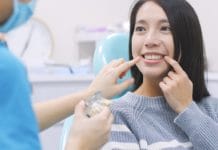Recently, at my annual well visit with my primary care physician, after the usual weight and blood pressure check, I was asked when I last had my eyes checked, when I last saw a dermatologist, when I last had a mammogram and so on. The one thing that was missing from these interview questions was when was my last dental check-up. As I waited to see my physician, I saw on the wall, a poster that gave statistics on diabetes and discussed the rise in the number of diabetic patients in the last ten years.
With all this information floating around in my brain, I decided to ask my doctor about the percentage of patients he sees that are diabetic.
When my doctor came in, I asked him just that, he informed me it was about 50%. Fifty percent of this doctor’s patients are diabetic, and he does not inquire about their last dental visit, this is a problem. Let me say, I think my physician is wonderful, and he is very thorough. However, I don’t understand why, with all the research that clearly links oral and systemic health, there is still a barrier between dental care and medical care. How amazing would it be to collaborate to improve patient’s total health? As healthcare professionals, we need to break this barrier.
I firmly believe dental professionals should be networking with medical professionals to set up a referral system as well as a system to follow up with patients with health concerns. I think the first step is to review medical history thoroughly by asking about the patient’s last visit to their primary care physician, date of their last CBC and hbA1c if they have diabetes. We should encourage patients to see their physician if they have not done so recently. Physicians should be asking about their patient’s last dental visit especially if they have systemic diseases.
When seeing patients, we screen for many different systemic diseases.
If a patient comes to their appointment and their blood pressure is high when taken, to who do we report this? Generally, no one other than the patient, apart from very few offices. If we had a referral system to open that line of communication, we could fax or email a report to their physician with the information we gathered at their visit. This would ensure the information was delivered to the physician’s office instead of relying on the patient to relay the information.
Dental hygienists are in the perfect position to be the advocate to break the barrier. One possibility would be to have your dentist sponsor a lunch and learn, so you could meet with physicians, nurses and office managers to further explain the advantages of this relationship and how it could benefit our mutual patients. Not only would this benefit existing patients, but it could improve the number of new patients coming into the office, in the long run, this would improve overall community health.
Having a list of physicians and referral slips for patients when we recommend they follow up with a physician, would lessen the burden on patients that are not already established with a primary care physician. If they are an established patient that you see often, they already trust you and are more likely to follow your recommendation. This puts dental hygienists on the front line in achieving total body health for their patients. The same would be true for physicians; if they had a list of dentists and referral slips for patients needing to be seen for a dental check-up.
Physicians encouraging patients to go for regular dental check-ups would also reduce the number of ER visits due to toothaches. Which in turn, might reduce the overuse of opioids. Okay, that might be a stretch, but you can see how this could snowball into a healthier community. I am confident that both the medical community and the dental community have the same goals for their patients, to live a healthier, longer life. Working together is the key to achieving this goal. So, fellow hygienists let’s step out of our comfort zone and into the medical community to network with nurses and doctors to provide the best care possible for all of our patients.












